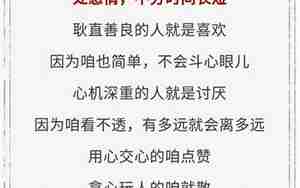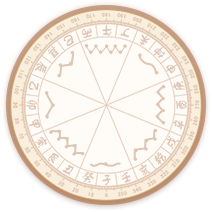当你错的时候句子


承认错误,智慧人生的必修课——中老年朋友的成长指南
在人生的道路上,每个人都有犯错的时候,无论是年轻时的冲动,还是年长后的经验不足,错误都是一种学习和成长的机会。而对中老年朋友来说,承认错误并从中吸取教训,更是保持活力与智慧的关键。让我们一起探讨,为何学会放下自我,勇于面对错误对这个阶段的生活如此重要。
段落一:理解错误的价值 \- 错误反映真实:如同美国心理学家Carol Dweck的"成长思维模式"理论,错误不是能力的否定,而是进步的线索。比如,一位70岁的老人在学习新技术时,如果能勇敢接受操作失误,就能借此理解并改正,提升自我适应能力。
段落二:从错误中学习 \- 实例教育:想象一下,一个80岁的园艺爱好者,因为不熟悉新品种的照顾方法,导致植物枯萎。但她没有埋怨,而是查阅资料,反而掌握了新的养护知识。这样的经历,让她的生活充满了智慧和乐趣。
段落三:提升社交技巧 - 错误与沟通:在人际关系中,承认错误能建立信任。比如,一个社区活动的组织者,因疏忽造成活动时间调整,诚恳地道歉并改正,反而赢得了其他成员的理解和支持。
段落四:保持开放心态 - 老年人的智慧:研究表明,中老年人更善于从经验中学习,他们明白,承认错误不是软弱,反而是展现成熟和稳重的标志,有助于保持心态年轻。
段落五:结语:勇敢承认,智慧成长 - 所以,中老年朋友们,无论何时何地,面对错误,都请像那棵经历了挫折的植物,坚韧地生长,让每一次的错误成为人生的垫脚石,通往更加智慧的人生旅程。
在这个阶段,承认错误并学会从中汲取教训,不仅能提升自我,更能丰富生活,让我们共同成长,活出智慧与坚韧。
当你错身而过的瞬间
擦肩而过的启示:生活的瞬间与错过
在人生长河中,我们时常会与无数人错身而过,那些瞬间,犹如微风拂过湖面,虽转瞬即逝,却可能在心中留下深刻的印记。错身而过,有时是机遇的擦肩,有时是遗憾的错过,但正是这些,构成了丰富的人生画卷。
段落一:错过与机遇
一位中年旅行者,曾在异国小镇巷口与一位陌生人对视而过。他未曾留意,却错过了和一位语言大师的一次交流机会。而正是那次错过,他学会了通过书籍和网络自我提升,最终掌握了新的语言技能,证明了错过有时也能成为成长的动力。
段落二:瞬间的启示
在生活中,也有这样的情景:在公园里,老者与一位艺术家擦肩而过,尽管没有交谈,他却从那专注的眼神中捕捉到艺术的真谛。这恰好提醒他,人生中错过的是信息,但内心的感悟是永恒的教育资源。
段落三:错过与回忆
对于中老年人来说,每一次与故人错身而过,都可能成为一段珍贵的记忆。他们学会了珍视眼前,理解错过也是一种回忆,是生活给予的宝贵的教训。
段落四:从错过中成长
人生的错身而过,让我们学会接受无法预见的变数。就像一位退休的音乐教师,她在公园里常错过与陌生人的音乐交流,但正是这种错过,让她领悟到,生活中的美好并非总在预设中,而是来源于对未知的开放与接纳。
段落五:生命中的片刻
所以,错身而过,不只是一次简单的相遇与错过,它是一次生活的提醒,教我们珍惜眼前,从每一个错过中汲取智慧。在中老年这个人生阶段,让我们学会欣赏并从错身而过的瞬间中获取生活的丰富内涵。
当你做错事情的时候要说什么
认错的艺术:中老年人的沟通与修复之道
人生总有犯错的时候,即使是经验丰富、智慧满溢的中老年人,也会面临需要道歉的时刻。正确的道歉方式不仅能修复关系,更能展现一个人的成熟与尊重。以下是一些建议,帮助你在犯错时,如何恰当表达。
段落一:真诚的道歉
承认错误至关重要。比如,如果你在组织社区活动中疏忽了时间,可以说。”真诚的语气传递了你承认错误的诚意。
段落二:承担责任
明确表示你愿意承担后果:“我理解我的错误,我愿意负责纠正并确保以后不再发生。”这显示了你的责任态度和改正的决心。
段落三:解释原因与承诺
解释你的错误来源于何处,同时提出改进计划:“我这次失误是由于我对流程理解不透彻,未来我会提前做好充分准备,保证这样的事情不再发生。”
段落四:倾听反馈
开放地听取他人的意见,表示你重视他们的感受:“我非常希望听到您的建议,让我知道我该怎么做才能弥补这次的失误。”
段落五:尊重他人
在道歉时,不要贬低他人或为自己辩解,而是保持谦逊:“我理解我的错误触动了您的感受,我向您道歉,并感谢您的理解。”
结语:持续改进
以承诺和行动结束你的道歉:“我会从这次错误中学习,希望得到您的原谅,我会用实际行动来证明我的改变。”
记住,真诚的道歉并不意味着急于求成,而是一个展现个人成长和尊重他人过程的开始。通过这样的沟通方式,中老年人可以更好地处理人际关系,保持和谐与包容。
当你做错事的时候英语翻译
Title: Apologizing with Grace: Responding to Mistakes for the Elderly
In the course of life, everyone makes mistakes, and it's particularly true for the elderly, who often bring a wealth of wisdom. Learning how to acknowledge and apologize in English is an essential part of maintaining strong relationships. Here's how you can effectively address a mistake in English.
Paragraph 1: Acknowledging Mistakes
A crucial first step in English is a sincere apology, such as, "I deeply regret my mistake." Make sure to use direct and honest language to express your regret.
Paragraph 2: Taking Responsibility
Following an apology, it's important to accept accountability: "I understand that my actions were in error, and I am accountable for the consequences." This shows you are willing to face the consequences and learn from them.
Paragraph 3: Explaining and Planning
Provide a clear explanation of what went wrong, and outline a plan to prevent recurrence, like, "I made a mistake due to miscommunication, and I'll ensure better communication moving forward."
Paragraph 4: Listening to Feedback
Listen actively to feedback, saying something like, "I really appreciate it when you let me know how I can improve." Demonstrating a willingness to learn is a sign of respect.
Paragraph 5: Showing Empathy
Remember to empathize with the person affected, like, "I understand how my error may have caused inconvenience, and for that, I am truly sorry." This helps to build empathy and strengthen connections.
Conclusion: Learning from Mistakes
In conclusion, when apologizing in English, remember that it's not just about saying sorry, but also growing from the experience. For the elderly, practicing effective communication can help foster an environment of understanding and forgiveness.
By employing these strategies, the elderly can navigate English apologies with grace, reflecting their maturity and ability to learn from their mistakes.
当你错了就在错中寻求真理
Title: Embracing Truth Through Mistakes: A Journey of Wisdom and Growth
In the intricate tapestry of life, mistakes is not a downfall, but rather a path to self-discovery and truth. As a mature individual, it's about recognizing our errors, being open to learning, and in doing so, finding deeper truths. Here's an exploration of how to approach truth-seeking within the context of error.
Paragraph 1: Acceptance and Reflection
The first step is acknowledging the mistake, like admitting, "I understand I made a mistake, and now it's time to look at it." This honest admission sets the foundation for introspection.
Paragraph 2: Seeking Insight
Once you've acknowledged the error, it's crucial to probe its roots, asking, "What caused this misstep, and what could I have done differently?" This self-analysis helps reveal hidden lessons.
Paragraph 3: Embrace Mistakes as Teachers
Remember, mistakes are not just failures; they're opportunities for growth. Every wrong turn can be a compass pointing us toward new understanding, as the philosopher Albert Einstein said, "I have not failed. I've just found 10,000 ways that won't work."
Paragraph 4: Learning from Others
Draw from the wisdom of others. If you've hurt someone, a sincere apology might be accompanied by, "I've learned from your perspective, and it has helped me gain a broader understanding." Seek guidance and constructive feedback.
Paragraph 5: Integrating Lessons into Action
The ultimate goal is to apply these lessons, turning them into actionable changes. For instance, "Based on what I've learned, I'll make sure to communicate more clearly in the future." This commitment to change showcases growth.
Conclusion: The Power of Transparency
In the end, the ability to acknowledge and seek truth through our mistakes sets us apart as we mature. By embracing these lessons, we not only correct the present, but also strengthen our character and foster a more profound understanding of ourselves and the world around us.
So, the next time you stumble, remember that the truth might just be waiting on the other side of that error, guiding you towards a clearer, wiser path.
当你的错误显露时
Title: Embracing Vulnerability: Unveiling and Learning from Mistakes
As we all embark on life's journey, we inevitably encounter moments where our errors come to light. These revelations can be uncomfortable, but they are gold mines of personal growth. Let's explore how to navigate these situations with grace and resilience.
Paragraph 1: Acknowledge the Moment
The first step is to admit the error, no matter how small or large, like saying, "I've made a mistake that I wasn't expecting." Being honest with yourself is the foundation of self-correction.
Paragraph 2: Embrace Vulnerability
Accept that vulnerability is a natural part of being human. It's not a sign of weakness, but a strength, because it allows for learning. Remember, "Being imperfect is part of our shared humanity."
Paragraph 3: Reflect and Learn
Take a moment to analyze the mistake, asking why it happened and how you might prevent it. For instance, "What factors led to this outcome, and what can I do differently next time?"
Paragraph 4: Seek Feedback
Ask for constructive criticism, as it can provide valuable insights, like, "I'd appreciate your honest feedback on how I could improve." Openness to feedback is a key to continuous growth.
Paragraph 5: Communicate Constructively
When sharing your mistake with others, communicate in a way that fosters understanding, not defensiveness. For example, "I realize I made a mistake, and I want to learn from it. Can you help me see it from your perspective?"
Conclusion: A Learning Curve
Remember, our mistakes are not endpoints, but rather milestones on the learning curve. By acknowledging and learning from them, we not only correct our errors but also enrich our lives with lessons that shape us into wiser individuals.
In the face of error exposure, let it be a call to grow, an invitation to deepen our understanding, and a testament to our capacity to evolve. It's in these moments of vulnerability that we truly shine.

